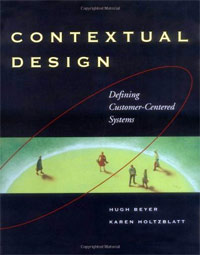
Buy it from Amazon
FYI, these are sometimes referral links!
| Subtitle | Defining Customer-Centered Systems |
| First Written | 1997 |
| Genre | Design |
| Origin | Russia |
| Publisher | Morgan Kaufmann |
| ISBN-10 | 1558604111 |
| ISBN-13 | 978-1558604117 |
| My Copy | library paperback |
| First Read | July 20, 2001 |
Contextual Design
You have to design with and for users, but also for business. If it's wonderfully usable but to conflicting with the company's aims, it won't get used.
A systemic response - not a list of features - keeps user work coherent.
Don't just put users in the designer's court - put designers on the users' turf. So we can learn what they're NOT saying.
Contextual design is a customer-centered process.
1. Contextual Inquiry. Talk to users, one-on-one, where they work.
2. Work Modeling. Create a conceptual model - a diagram - of how the user's work works.
3. Consolidation. User affinity diagrams to create consolidated models to show the underlying structures and similarities in the different groups work models.
4. Work Redesign. Create a corporate response to users issues - define how the new system works by using storyboards.
5. User Environment Design. Structure the system work to fit the user work (note - haven't you already?)
6. Mockup and Test - with paper prototypes. Don't code until you know WHAT to code.
1. 4 Principles of contextual inquiry: Context, partnership, interpretation, and focus.
Be Nosy. Be an apprentice. DO NOT be a guru, expert, guest, or interviewer.
2. Study analogous work!
3. Don't let individual differences blind you to common work patterns.
Noted on May 6, 2010